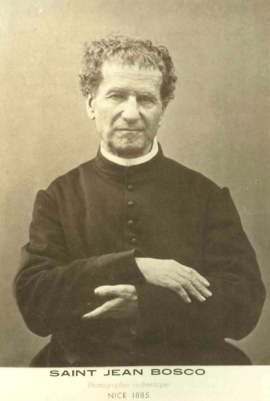The question, which has fascinated dozens of Salesian scholars, also captivated Salesian Giuseppe Soldà, a still-living Salesian from the Province of Northeastern Italy (INE), a few years ago, who in a valuable volume presented the photos of Don Bosco, cataloging and describing them and trying to offer a complete and reasoned collection of the entire corpus.
In his work Fr. Soldà observed how in order to trace back to the most authentic images of Don Bosco it was necessary to carry out a careful work of analysis of the pictures, to eliminate those retouches typical of the time and motivated mostly by hagiographic reasons.
For this reason he identified as among the most "faithful" photos the one taken in Nice in 1885, which appears with little or no retouching, and the photograph taken in Sarriá, near Barcelona, Spain, the following year, of which the negative is even preserved.
Don Bosco stayed in Nice from March 25 to April 1, 1885, on one of his several trips made to the Salesians sent to France, the first country, after Italy, to welcome his spiritual children. At that time Don Bosco was almost 70 years old, and the photo faithfully shows a man already old and tired, with a face marked by the fevers that struck him in the changes of seasons, with the appearance of a tenacious and strong-willed peasant, with eyes both penetrating and suffering, with industrious and energetic hands and curly hair. The left eye, in particular, is still lively and penetrating, while the right is visibly dull.
Don Bosco, on the whole, has an unkempt face, certainly not "holy, card-like"; but it should not be forgotten that it was certainly not out of vanity that Don Bosco lent himself to being photographed: indeed, the accounts in the Biographical Memoirs give testimony to his reluctance to such poses (which also required a certain amount of time waiting motionless); but that he eventually condescended to do them as a gesture of courtesy to benefactors and friends who wished to have a portrait of Don Bosco all to themselves, or to foster through the photos the sense of his presence and the family atmosphere in the Salesian homes.
Sarriá's photo was taken on April 29, 1886, during a trip by Don Bosco to the recently founded Salesian presences in Spain. Don Bosco's secretary on that trip, Fr. Viglietti, accounts for several photos taken that day, including one at the altar where he was distributing Communion to the faithful. However, only two very similar photos came of that session, but with a slightly different field of framing and a different pose of the hands, in both cases however with Don Bosco portrayed sitting in his room. The photos, taken by a professional, Raimundo Fages Buxó, were not very good, mainly because the lighting conditions were poorly chosen and half of Don Bosco's face appears in shadow.
In the closer version, Don Bosco appears even older and tired, with his mouth pulled tight and lacking a smile and the two large cheekbone folds very pronounced.
In the wider version, Don Bosco's figure can be seen in full, and a table on which a statue of the Virgin and a book rest as choreographic elements additionally emerges.
Looking at these selected photos, in spite of the retouches and the more easily handed down images, Don Bosco appears with rather "hard" and marked features and a square face, a typical peasant figure, but with a gaze that, though flushed, is still alive, intelligent and shrewd.



